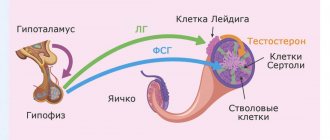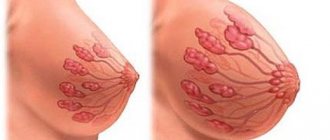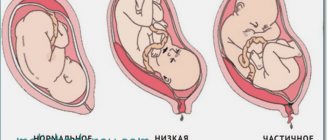- From the moment of pregnancy, a complex of changes occurs in a woman’s body, which covers the functions of all organs and systems, is observed throughout pregnancy and is within the physiological boundaries characteristic only of the state of pregnancy.
The set of changes includes:
- cessation of menstruation (changes occur in the mucous membrane of the uterine cavity caused by changes in the functional state of the ovary);
- prolonged low-grade fever (the influence of progesterone, an ovarian hormone, on the thermoregulation center in the brain);
- formation of the placenta - a new endocrine gland;
- change in a woman’s appearance;
- the emergence of a pregnancy dominant in the cerebral cortex, which ensures clear coordination of the functions of all organs and systems in the interests of the developing fetus;
- changes in the function of the endocrine glands;
- changes in the uterus (the greatest changes compared to other organs);
- changes in metabolism;
- changes in hematological (blood) and hemodynamic (blood movement) parameters;
- change in circulating blood volume;
- changes in the blood coagulation system;
- changes in the functioning of the cardiovascular system.
That is, with the onset of pregnancy, your body begins to completely restructure its functioning. He is preparing to bear the fruit, give birth and feed the child. Therefore, such a restructuring is a normal state for a pregnant woman.
| A healthy person has the same indicators (the numbers you see on the analysis form are normal), for example, blood indicators, urine indicators, etc. |
| For a sick person , there are indicators; they vary depending on the patient’s condition and his disease. |
| A pregnant woman is her own story. Her laboratory values may vary depending on the physiological course of pregnancy. Moreover, in different trimesters of pregnancy, each indicator has its own norm, and these norms for a pregnant woman do not coincide with the norms for a healthy person. |
Moreover, sometimes what is normal for a pregnant woman is considered pathological in a non-pregnant woman. But for a man it’s generally fatal; you can’t live with something like that.
Dear men, loving husbands!
Remember that your pregnant wife is an “unusual” person the entire time she is carrying your child. That is why a loving husband should not allow his wife to overwork herself with housework. A pregnant woman needs to create favorable conditions so that she can safely bear and give birth to a child, i.e. so that her body can qualitatively adapt to changing conditions as the pregnancy progresses (the baby grows, develops, eats, “breathes,” etc. - conditions are constantly changing).
If a pregnant woman’s body cannot adapt normally, then she will experience various unfavorable conditions, primarily for the child. For a woman, these are also unfavorable conditions. In especially severe cases, pregnancy is sacrificed to save the woman, because... terminating a pregnancy in this condition immediately leads to recovery (conditionally to recovery), but your child will no longer be born.
Always take care of women! And especially during pregnancy!
The fetoplacental system is like a new endocrine gland
After implantation of the zygote in the uterine cavity, a new endocrine gland begins to form in the woman’s body - the placenta (baby place).
The placenta has two parts: fetal and maternal, the blood circulation of which never mixes. These parts of the placenta are as close as possible, which allows for the exchange of substances between the body of the mother and the fetus, i.e., in essence, allows the child to “eat, write and breathe,” and, therefore, grow and develop.
Metabolism between the mother and fetus is the main factor for its development. The exchange is carried out due to the permeability of the placenta, which is disrupted in most acute and chronic complications during pregnancy. Violation of the integrity of parts of the placenta and deterioration of its permeability leads to fetal death and termination of pregnancy.
The death of the fetus and termination of pregnancy is also possible for another reason, when the mother’s body suddenly decides that the fetus is a foreign protein for it. But this is actually true. However, nature has provided a protective mechanism that does not allow the mother's immune system to recognize antigens of paternal origin embedded in the child.
This protective mechanism consists of certain factors that block the mother’s immune system and provide local immunological comfort. With spontaneous abortions, blocking factors in the mother's blood are reduced or absent.
The placenta produces a wide range of hormones and specific proteins that enter the mother's blood and amniotic fluid. They regulate the normal course of pregnancy and fetal development by changing the function of other endocrine glands and life support organs in general.
By the level of hormones and specific proteins of the placenta, determined in the mother’s blood, in the fetal blood or in the amniotic fluid, the condition of the fetus and the function of the placenta can be assessed, which is what obstetric endocrinology deals with. Thus, studying the endocrine function of the fetoplacental complex can significantly improve the diagnosis of the fetal condition at different stages of pregnancy.
The appearance of a new endocrine gland leads to other changes in the female body.
The appearance of a woman changes. Appears:
- pigmentation of the skin (forehead, cheeks, chin, upper lip, white line of the abdomen, nipples and parapapillary zones), which is associated with significant stimulation of pigment formation by skin cells. The formation of pigment depends on the melanoform hormone of the adrenal gland, increased production of which occurs during pregnancy;
- low-grade body temperature is noted , which can last up to 16-20 weeks of pregnancy and is associated with hormonal fluctuations.
From the moment the placenta begins to produce progesterone, the temperature decreases and returns to normal.
- There is engorgement and soreness of the mammary gland due to an increase in its volume as a result of the proliferation of glandular tissue, enlargement of the nipples and protrusion of the areolar glands. In the second half of pregnancy, colostrum may be released;
- violation of facial proportions (enlargement of the nose, lips, chin, thyroid gland, especially in the second half of pregnancy), some enlargement of the limbs;
- stretching of the tissues of the anterior abdominal wall , mammary gland, thighs and the appearance of striae (“pregnant stripes”) in these areas (stria gravidarum). Their occurrence is associated with excessive stretching of the abdominal wall; this is more often observed in persons with a large abdominal volume (large fetus, polyhydramnios, multiple pregnancy) or with some lack of elastic fibers in the skin;
- varicose veins worsen or appear for the first time , especially in the lower extremities;
- The “proud posture and gait” of a pregnant woman is caused by a shift in the center of gravity of the body , increased mobility of the pelvic joints and limited mobility of the hip joints.
- Progressive increase in body weight , which is caused both by the growth of the fetus and uterus, and by the characteristics of metabolic processes and fluid retention in tissues. The average weight gain during pregnancy is 10-12 kg, of which 5-6 kg is due to the fertilized egg (fetus, placenta, amniotic fluid), 1.5-2 kg for enlarged uterus and mammary glands, 3-3.5 kg - to directly increase a woman’s body weight.
Before childbirth (3-4 days), a pregnant woman’s body weight drops by 1.0-1.5 kg, due to the peculiarities of metabolic processes.
The structure of the external (and internal) genital organs changes
- The external genitalia become swollen and hyperemic. Cyanosis of the mucous membranes of the vaginal part of the cervix, vagina and its vestibule occurs, which indicates vasodilatation and blood stasis, facilitating serous permeation of the tissues necessary for the deposition of nutrients at the site of attachment of the fertilized egg to the uterine wall.
- The vagina expands and lengthens somewhat during pregnancy. The walls of the vagina are swollen and thickened. The discharge becomes more abundant, mucous in nature, milky white or yellowish in color with an acidic reaction. In a healthy pregnant woman, the vagina has I-II degrees of cleanliness.
The uterus changes the most during pregnancy compared to other organs.
Its size increases during pregnancy in all respects:
- weight - from 50-100 g to 1-2 kg!!!
- length - from 7-9 cm to 50 cm,
- volume - 500 times, reaching 2-3,000 cm3 (liters) or more.
Accordingly, changes occur in all tissues, blood supply and innervation of the uterus:
- The shape and position of the uterus changes during pregnancy. As the uterus grows, it emerges from the pelvis into the abdominal cavity, rising in the 9th month of pregnancy to the xiphoid process. The shape of the uterus is asymmetrical due to the bulging of the part where the placenta is attached.
- Thin arteries and veins of the uterus turn into powerful trunks, which become corkscrew-shaped, tortuous, which allows maintaining normal blood supply during pronounced changes in the uterus during pregnancy and during contraction of its muscles during childbirth.
- The volume of blood circulation in the uterus during pregnancy increases tens of times, providing uteroplacental blood flow, which is carried out according to the principle of blood supply to vital organs and remains relatively optimal even under various stresses (blood loss, anemia). This ensures the survival of the fetus in extreme situations.
- The receptor system of the uterus changes: during pregnancy, the sensitivity of the uterus to stimulating factors decreases, before childbirth, the excitability of the uterus increases, some of the nervous structures are lost in order to reduce pain information from the uterus during childbirth.
With the appearance of the placenta, a pregnancy dominant arises in the cerebral cortex, which ensures clear coordination of the functions of all organs and systems in the interests of the developing fetus.
Women note a decrease in performance, increased drowsiness, or vice versa, they are irritated, they have nausea, drooling, periodic vomiting, which is classified as mild and the occurrence of which corresponds to the phase of functional changes in the nervous system.
Pregnant women have increased suggestibility and self-hypnosis, which is taken into account when conducting psychoprophylactic preparation for childbirth.
Phenomena of paresthesia, neuralgic pain, spasms of muscle groups, numbness of the fingers and other disorders may occur. Increased excitability of peripheral nerves is also manifested by increased knee reflexes.
With all this, sexual excitability decreases , and you, dear husbands, must be prepared for this. No need, under no circumstances!!! (remember about increased suggestibility and self-hypnosis) do not show your grievances that your wife is cold and inattentive to you, which means she has stopped loving you. She still loves you, she is already carrying your child and she has a dominant in her cerebral cortex - to endure pregnancy at all costs. And there is no escape from this.
- In a pregnant woman, the functions of some analyzers change - hearing, vision, smell!!! A pregnant woman's sense of smell can become so strong that the woman will react to the lightest (hardly perceptible) odors.
Please keep in mind, dear men, when a woman feels bad, feels sick, and the world is generally in shades of grey, for some reason unhappy thoughts come into her head, which can lead to a deterioration in her condition and, as a consequence, to termination of pregnancy.
During pregnancy, changes affect other organs as well.
The adrenal glands increase in size during pregnancy due to cortical hyperplasia, and the glucocorticoid and mineralocorticoid function of the adrenal glands increases accordingly.
Strengthening the function of the adrenal cortex during pregnancy is aimed at increasing protective and adaptive mechanisms, including during childbirth.
The thyroid gland increases in volume and function increases. Goiter in pregnant women is observed, especially in areas endemic for goiter (little iodine in soil and water) and hyperthyroidism without thyrotoxicosis. Strengthening the function of the thyroid gland is associated with the influence of placental hormones on it. Clinical thyrotoxicosis does not develop due to increased binding of free hormones by plasma proteins. The protein-bound form of the hormone is subsequently utilized by the fetus and the mother’s body, since the need for it increases with the development of pregnancy, before the onset of fetal thyroid function.
The parathyroid glands (calcium metabolism) undergo hypertrophy, their functional activity increases due to the increased need for calcium, which is a plastic material for the formation of the musculoskeletal system of the fetus. If there is insufficient intake or impaired absorption, the fetus receives calcium from the tissues of the mother’s body (bones, teeth), which can manifest itself as osteoporosis, fragility and dental caries. During pregnancy, the concentration of calcium in the blood increases. The content of phosphorus compounds, iron and a number of microelements (cobalt, iodine, manganese, copper) also decreases in the blood plasma. The deficiency of these substances is due to the needs of the fetus and increased metabolic reactions, the enzyme systems of which include some of the micro- and macroelements.
Pancreas – strengthening the function of the insulin-producing apparatus. As a result, carbohydrates are absorbed very well and are deposited in the mother’s liver and in the tissues of the fetus. Women with diabetes always give birth to large children due to the utilization of excess carbohydrates by the fetus. Some pregnant women experience glucosuria (sugar in the urine), which is not pathological and manifests itself with normal or even low carbohydrate levels in the blood.
The pituitary gland in pregnant women increases in volume and is difficult to fit in the sella turcica; hyperproduction of growth hormone (GH) is observed, which, penetrating the placenta, stimulates the growth of the embryo. This hormone also affects the lactogenic function of the mammary gland, causing in some cases an enlargement of the nose, lips, and fingers.
Functions of estradiol in the male body
The hormone estradiol in men - what is it? The female sex hormone is found in small concentrations in the male body. Its level in blood plasma does not exceed 3-55 pg/ml. Estrogens are formed from anabolic hormones under the influence of the aromatase enzyme. It is also produced by adipose tissue cells, and therefore, with obesity, feminization of men occurs, the manifestations of which are: gynecomastia;
- decreased libido;
- female type hair growth;
- change in voice timbre;
- erectile dysfunction;
- thickening of the fat layer at the hip level.
Normal estradiol levels are important in maintaining sexual function and fertility. It prevents baldness and is an important factor in maintaining bone density and lipid metabolism. A deficiency or excess of this substance can lead to the development of pathological processes in a man’s body.
Effect of pregnancy on kidney function
Renal blood flow increases and glomerular filtration increases (maximum in mid-pregnancy) - associated with the excretion of metabolic products of the woman and the fetus.
The permeability of the kidneys to protein and carbohydrates increases: proteinuria (protein in the urine), glucosuria. The excretion of 140 mg/day of glucose in the urine is considered the upper limit of the physiological norm. Peak glucose secretion was detected at 9 months of pregnancy.
The peristaltic function of the ureters is sharply suppressed, as a result of which they expand and urine is retained in them. Atony of the ureters leads to impaired drainage of urine from the pelvis, which creates favorable conditions for the development of pyelonephritis in pregnant women. In the postpartum period, these phenomena soon disappear.
What are FSH and LH
Follicle stimulating hormone (FSH)
is a hormone produced by the pituitary gland. It affects the formation (maturation and growth) of female follicles and male sperm.
Luteinizing hormone (LH)
is a hormone that is involved in the process of ovulation. It stimulates the development of the genital organs. In men, it promotes the development of sperm. Luteinizing hormone is produced in the pituitary gland. FSH and LH are classified as gonadotropic hormones because they are produced by gonadotrophs (cells of the anterior pituitary gland).
Effect of pregnancy on liver function
The liver during pregnancy is in a state of high functional tension. However, in healthy women during the physiological course of pregnancy, the functioning of the liver is not impaired.
Noted:
- slight increase in liver size in the absence of pronounced histological changes;
- there is a decrease in the antitoxic function of the liver;
- the level of protein in the blood serum decreases, by the time of childbirth it can reach 60 g/l;
- the result of changes in the composition of serum proteins is an increase in ESR;
- blood clotting and fibrinolysis changes. These changes help increase blood clotting ability.
Thyroid hormones
Testing for thyroid hormones is an important part of preparing for pregnancy; pregnant women should also take it. These substances are actively involved in the work of the ovaries; going beyond the norm can create conditions for the development of infertility.
- T3 is free
. This is a substance of the thyroid gland that is responsible for the absorption and exchange of oxygen by tissues. - T4 is free
. This hormone carries out the synthesis of proteins in the body. - Thyroid-stimulating hormone (TSH)
. It is responsible for the functioning of the thyroid gland; a change in its concentration level indicates thyroid disease.
This is the main list of hormonal tests that a woman is recommended to undergo in preparation for pregnancy.
Function of the gastrointestinal tract
There are changes in the function of the gastrointestinal tract. A number of women experience a perversion of taste sensations such as aversion to certain types of food (meat, fats), the appearance of taste whims (the desire to eat even clay, chalk), an increase in appetite, and in some cases its decrease. Due to a decrease in gastric secretion, the evacuation ability of the stomach slows down. Intestinal function in pregnant women is characterized by decreased tone and decreased intestinal motility, which determines the tendency to bloating, constipation, and hemorrhoids.
Metabolism
Characterized by an increase in metabolic processes.
- Basal metabolism and oxygen consumption increase, especially in the second half of pregnancy and childbirth.
- Changes in water-electrolyte metabolism are characterized by fluids.
- Carbohydrate metabolism is characterized by an increase in glucose in the blood, and when the body is overloaded with carbohydrates, it appears in the urine (glucosuria). During pregnancy, latent forms of diabetes mellitus appear.
- The content of fats and cholesterol in the blood increases, but no pathological manifestation of this condition is observed. There is increased fat deposition with a characteristic distribution in the subcutaneous tissue, mammary glands, lower abdomen, thighs, and buttocks. Fats are used to build the tissues of the body of the mother and fetus, and are also energy material.
- During pregnancy, there is an increased need for vitamins (A, B, D, C, E, K, PP).
- In some women, due to pregnancy, sweating increases and the discharge of liquid salts from the vagina, which are a mixture of mucus and transudate of the vasculature of the genital organs, increases.
The variety of external and internal changes in a woman’s body increases with increasing pregnancy, are characteristic only of the state of pregnancy and are aimed at creating optimal conditions for the development of the fetus and the course of labor.
That is why the norms characteristic of non-pregnant women cannot be transferred to pregnant women.
The norm of pregnancy is considered to be the average statistical indicators of functional tests characteristic of uncomplicated development of pregnancy.
Each trimester of pregnancy has its own norms. Knowledge of the norms allows you to avoid unreasonable actions that can cause a violation of the physiological balance established between the fetus and the mother’s body.
Thank prolactin for breast milk
Prolactin is responsible for the production of breast milk, and your body produces this hormone during and after pregnancy. Thanks to it, milk will come, its quantity will increase, and feeding itself will provoke greater production of the hormone.
During pregnancy, you will most likely notice a variety of changes caused by hormones. Learn exactly how hormones help your body during this amazing time in your life and share it with a loved one who supports you throughout your pregnancy. After all, when you understand what exactly is happening to your body, it will be much easier for you to survive possible physical or emotional discomfort.









